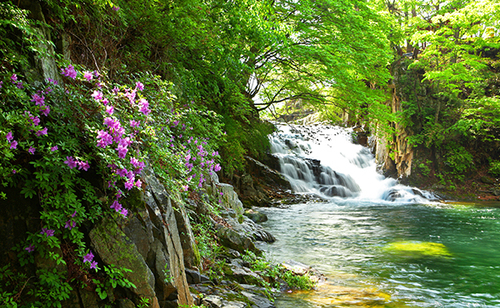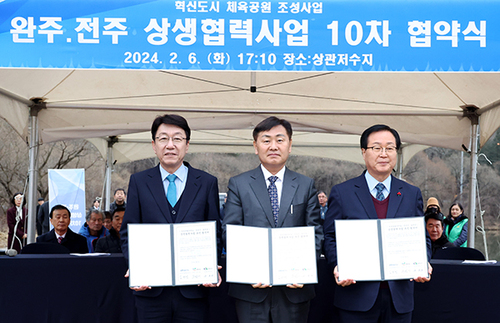| ▲ 구석기시대 사냥용 도구인 '슴베찌르개' 등이 출토된 전북 임실군 하가 유적의 고고학적 가치가 매우 높아 전라북도 기념물로 지정 예고됐다. (용요산에서 뻗어 내린 긴 능선의 끝자락 완만한 구릉에 위치했고 큰 S자를 그리며 흐르는 섬진강 신평천과 맞닿아 있다 = 신평면 가덕리 약 32,191㎡의 '임실 가덕리 하가 구석기 유적' 전경) / 사진제공 = 임실군청 © 김현종 기자 |
|
구석기시대 사냥용 도구인 슴베찌르개 등이 출토된 전북 임실군 하가 유적의 고고학적 가치가 매우 높아 전라북도 기념물로 지정 예고됐다.
전북 임실군은 "신평면 가덕리 약 32,191㎡의 '임실 가덕리 하가 구석기 유적'이 지난 18일 전라북도 기념물로 지정 예고됐다"고 22일 밝혔다.
하가 유적은 구석기시대 연구의 불모지였던 전북에서 조선대학교 박물관 연구팀의 지표조사로 2000년에 처음 발견됐으며 용요산에서 뻗어 내린 긴 능선의 끝자락 완만한 구릉에 위치했고 큰 S자를 그리며 흐르는 섬진강 신평천과 맞닿아 있다.
특히 ▲ 각추상석기(모뿔석기) ▲ 나이프형 석기 ▲ 돌확모양석기 ▲ 각종 찌르개류 ▲ 좀돌날몸돌 등 27,000여 점이 출토됐다.
유적의 탄소연대측정 결과, 대략 기원전 21,300년~21,500년대 후기 구석기시대에 해당하며 문화재로 지정된 32,191㎡를 포함 약 10만㎡ 정도로 넓게 분포됐다.
조선대 박물관은 2006년부터 2011년까지 다섯 차례의 학술발굴을 진행하여 중기와 후기구석기시대 문화층ㆍ신석기시대 문화층ㆍ삼국시대 문화층이 차례로 남아있음을 밝혀냈다.
하가 유적은 구석기시대 지형이 잘 보존돼 있을 뿐만 아니라 문화층의 규모가 10만㎡ 이상으로 추정되는 대규모로 많은 석기제작소와 함께 27,000여 점의 유물이 출토돼 구석기시대의 풍부한 문화상을 여실히 보여줬다.
일본열도에서 보고된 각추상석기(모뿔석기)와 나이프형석기가 발견돼 구석기시대에 일본열도와 문화교류를 연구하는데 있어 중요한 학술자료로 평가받아 학계에 비상한 관심을 모았다.
현재 국가사적으로 지정된 ▲ 석장리유적 ▲ 전곡리유적 ▲ 수양개유적 ▲ 월평유적과 비교해 손색이 없고 유적의 탁 트인 경관은 탐방객들에게 호쾌한 인상을 선사한다는 평이 지배적이다.
임실 하가유적에서 출토된 구석기 암석 재료는 산성화산암이 90%를 웃돌고 최종 구석기 생산품으로 가는 전 단계 또는 그 과정에서 나온 석기가 많다는 점이 특징이다.
전북도 문화재심의위원회는 하가 유적에 출토된 '슴베찌르개'는 한반도에서 일본으로의 석기 기술의 이동과 관련이 매우 높을 뿐만 아니라 '모뿔석기(각추상석기)'의 경우 일본과 중국에서 발견될 사례가 높은 석기형식으로 한ㆍ중ㆍ일 석기문화의 교류 양상을 살펴볼 수 있는 등 고고학적 가치가 매우 높다고 판단했다.
심 민 임실군수는 "임실 가덕리 후기 구석기 유적은 한반도 구석기 문화를 대표하는 유적인 만큼, 지속적인 발굴과 연구를 통해 가치를 높여 나가는 동시에 군민들에게 문화적 자긍심을 심어줄 수 있도록 역사와 문화가 살아 숨 쉬는 건강한 임실 조성 및 국가 사적 지정에 행정력을 모으겠다"고 말했다.
☞ 아래는 위 기사를 구글 번역이 번역한 영문 기사의 '전문' 입니다.
구글 번역은 이해도를 높이기 위해 노력하고 있으며 영문 번역에 오류가 있음을 전제로 합니다.
【Below is the 'full text' of the English article translated by Google Translate.
Google Translate is working hard to improve understanding, and assumes that there are errors in the English translation.】
Imsil Haga Paleolithic Site Notice of 'Provincial Monument Designation'
More than 27,000 items including tangbejirgae and cone-shaped stone tools (cornered stone tools) have been excavated.
Reporter Lee Yo-han
The cultural asset value of the Haga site in Imsil-gun, Jeollabuk-do Province, where a hunting tool such as a tumbler, was excavated from the Paleolithic era, has been announced as a Jeollabuk-do monument.
Imsil-gun, Jeollabuk-do announced on the 22nd that "the 'Imsil Gadeok-ri Haga Paleolithic Site' of about 32,191㎡ in Gadeok-ri, Sinpyeong-myeon was designated as a Jeollabuk-do monument on the 18th."
The Haga ruins were first discovered in 2000 as a surface survey by a research team at the Chosun University Museum in Jeonbuk, a wasteland for Paleolithic research. It is touching.
In particular, more than 27,000 items were excavated, including ▲ cone-shaped stoneware(conical stoneware) ▲ knife-type stoneware ▲ stone-shape stoneware ▲ various types of stabbing tools ▲ jagged stones.
As a result of carbon dating of the remains, it corresponds to the Upper Paleolithic Age, approximately from 21,300 to 21,500 BC, and is spread over a wide area of about 100,000 m2, including 32,191 m2 designated as a cultural property.
The Joseon University Museum conducted five academic excavations from 2006 to 2011, revealing that the cultural layers of the Middle and Late Paleolithic Age, the Neolithic Age, and the Three Kingdoms Period remained in order.
The Haga site not only has well-preserved topography of the Paleolithic Age, but also has a large-scale cultural layer estimated to be more than 100,000 square meters, and 27,000 artifacts were excavated along with many stone tool mills, showing the rich cultural aspects of the Paleolithic Age.
Convex stone tools and knife-shaped stone tools reported in the Japanese archipelago were discovered, and it was evaluated as an important academic material for studying cultural exchange with the Japanese islands in the Paleolithic Age, drawing extraordinary attention from the academic world.
It is comparable to ▲ Seokjang-ri Site, ▲ Jeongok-ri Site, ▲ Suyanggae Site, and ▲ Wolpyeong Site, which are currently designated as national historic sites.
The Paleolithic rock materials excavated from the Imsil Haga site are characterized by the fact that acidic volcanic rocks account for more than 90%, and many stone tools from the previous stage or process leading to the final Paleolithic product.
Jeonbuk Provincial Cultural Heritage Deliberation Committee found that 'Tembejirgae' excavated from the Haga ruins is highly related to the movement of stone tool technology from the Korean Peninsula to Japan, and in the case of 'angular stone tools', cases to be found in Japan and China It was judged that the archaeological value was very high, such as the exchange aspect of the stoneware culture of Korea, China, and Japan, as a stone tool with a high value.
Sim Min, Imsil County Governor, said, "As the Imsil Gadeok-ri Late Paleolithic remains represent the Paleolithic culture of the Korean Peninsula, we are raising their value through continuous excavation and research, while at the same time creating a healthy environment where history and culture live and breathe so as to instill cultural pride in the people of the county." We will concentrate our administrative power on the creation of Imsil and designation as a national historic site."





















 많이 본 뉴스
많이 본 뉴스











